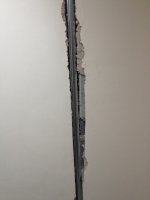The electrics are now done in the house (complete rewire). But with that there are 16 chases to be filled in (mostly all the same size). As we've just spent money on electrics and a new bathroom to come I'm thinking of having a go at filling in the chases in one of the rooms to see how I get on. If it goes well, great, if it goes terribly I'll just suck it up and get someone in. Loads of people have told me don't bother, but I'm having a go in a room that doesn't really matter.
Do we have any dab-handed plasterers here who can point me in the right direction of what I need?
I see a lot of people brush diluted PVA over the chases first and wait to dry. Then a bonding undercoat or two (depending on how many are needed). Do I then put a finishing coat (skim) on or can I just orbital sand it back?

Do we have any dab-handed plasterers here who can point me in the right direction of what I need?
I see a lot of people brush diluted PVA over the chases first and wait to dry. Then a bonding undercoat or two (depending on how many are needed). Do I then put a finishing coat (skim) on or can I just orbital sand it back?




 (maybe it will be haha!).
(maybe it will be haha!).